
Princess Margriet of the Netherlands is the third daughter of Queen Juliana and Prince Bernhard. As an aunt of the reigning monarch, King Willem-Alexander, she is a member of the Dutch Royal House and currently eighth and last in the line of succession to the throne.

Pieter van Vollenhoven Jr. is the husband of Princess Margriet of the Netherlands and a member, by marriage, of the Dutch royal house.
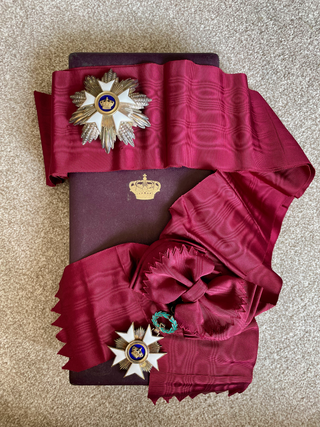
The Order of the Crown is a national order of the Kingdom of Belgium. The Order is one of Belgium's highest honors.

The Order of Orange-Nassau is a civil and military Dutch order of chivalry founded on 4 April 1892 by the queen regent, Emma of the Netherlands.
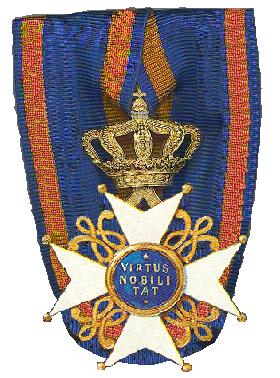
The Order of the Netherlands Lion, also known as the Order of the Lion of the Netherlands is a Dutch order of chivalry founded by King William I of the Netherlands on 29 September 1815.

The Order of the House of Orange, sometimes referred to as the House Order of Orange, is a dynastic order of the House of Orange-Nassau, the royal family of the Netherlands similar to the Royal Victorian Order in the United Kingdom. The order was instituted by Queen Wilhelmina of the Netherlands on 19 March 1905 and is not subject to ministerial responsibility or influence, but is awarded at the discretion of the Dutch monarch alone.

The Order of the Oak Crown is an order of the Grand Duchy of Luxembourg.
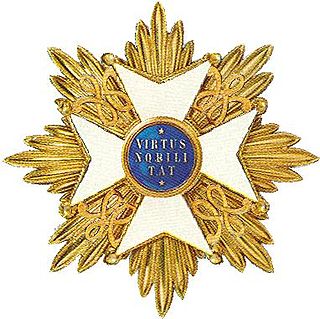
In the Dutch honours system, most orders are the responsibility of ministers of the Netherlands Government. The house orders, however, are awarded at the discretion of the Dutch monarch alone.
The Honorary Medal for Charitable Assistance was created at 18 June 1822 and is after the Military William Order the oldest decoration for bravery in the Kingdom of the Netherlands. Furthermore, the Honorary Medal is the highest civilian decoration still being awarded for bravery, and is specifically for those who carried out a voluntary act of bravery or self-sacrifice, with an emphasis on charity.
The Honorable Mention was an important Military awards and decorations of the Kingdom of the Netherlands for those who distinguished themselves by acts of high bravery, but weren't eligible yet for the highest accolade of the Military William Order. The Honorable Mention was in fact not a medal but a mention in the proclamation of the Dutch army, to honor the soldier.
The Honorary Medal for Merits toward Museum Collections, also known as the Museum Medal, is one of the oldest civil decorations of the Netherlands. It was created by royal decree on 26 June 1817 by King William I of the Netherlands. The decree describes the following: "Erepenning voor blijken van belangstelling in 's Rijksverzamelingen door schenking betoond". The medal is awarded in gold, silver or bronze as a token of appreciation to those who "aan hen, die enig boek- of kunstwerk, dat de vrucht van hun arbeid was, de Koning deden toekomen".
The Decoration of Merit is an important military decoration for bravery in the Netherlands. The medal was established by the Dutch minister of defence, Wim van Eekelen, on 16 April 1987. The award was created by ministerial decree and is therefore a medal of the Netherlands Ministry of Defence and not a royal decoration.
The Civic Decoration is a civilian decoration of the Kingdom of Belgium. It was first established by royal decree on 21 July 1867 to reward exceptional acts of bravery, devotion or humanity. A further royal decree of 15 January 1885 extended the award to state civil servants for long service by a mere change of ribbon. The award statute was once again amended by royal decree in 1902 to include long service in the Civic Guard and firefighters, each with its distinctive ribbon.
The Croix de guerre (French) or Oorlogskruis (Dutch) is a military decoration of the Kingdom of Belgium established by royal decree on 25 October 1915. It was primarily awarded for bravery or other military virtue on the battlefield. The award was reestablished on 20 July 1940 by the Belgian government in exile for recognition of bravery and military virtue during World War II. The post-1940 decoration could also be awarded to units that were cited. The decoration was again reestablished by royal decree on 3 April 1954 for award during future conflicts.

The Cross for the Four Day Marches is a Dutch Royal decoration awarded for successful participation in the International Four Days Marches Nijmegen held annually at Nijmegen, The Netherlands. The full title of the decoration is Kruis Voor Betoonde Marsvaardigheid. It is more commonly referred to as the Vierdaagse Cross or Vierdaagsekruis.
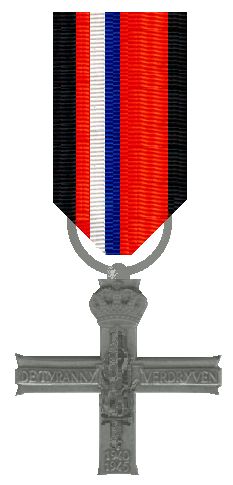
The Resistance Memorial Cross or Resistance Commemorative Cross is a medal awarded in the Netherlands to members of the Dutch resistance during the Second World War.

The 1940–1945 Military Combatant's Medal was a Belgian war medal established by royal decree on 19 December 1967 and awarded to all members of the Belgian Armed Forces who fought from the United Kingdom during the Second World War.
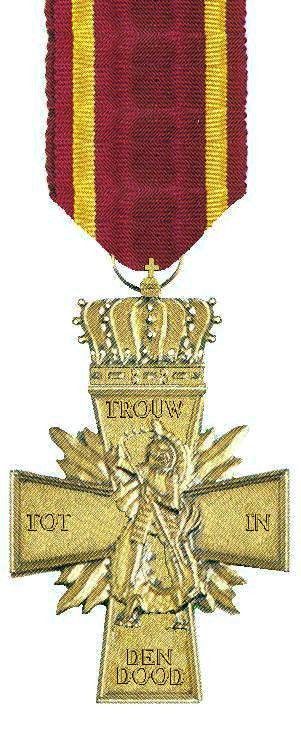
The Verzetskruis 1940–1945 is a decoration for valour in the Netherlands. Instituted on May 3, 1946, it was awarded in recognition of the individual courage shown in resistance against the enemies of the Netherlands and for the maintenance of liberties. It is one of the highest decorations in the Netherlands.

The Decoration for Order and Peace is a military award of the Netherlands. The medal was established on 12 December 1947 by royal decree of Queen Wilhelmina. The medal commemorates at least three months of service in the Dutch East Indies and adjacent waters during the Indonesian National Revolution. It was awarded to members of the Netherlands Armed Forces and the Royal Netherlands East Indies Army. Recipients who were engaged with hostile parties in a military context could be awarded clasps indicating the year of the action.
This page is based on this
Wikipedia article Text is available under the
CC BY-SA 4.0 license; additional terms may apply.
Images, videos and audio are available under their respective licenses.













